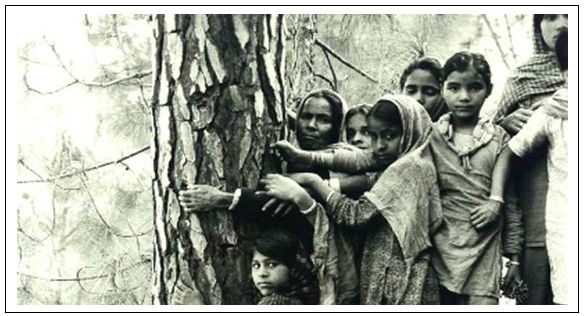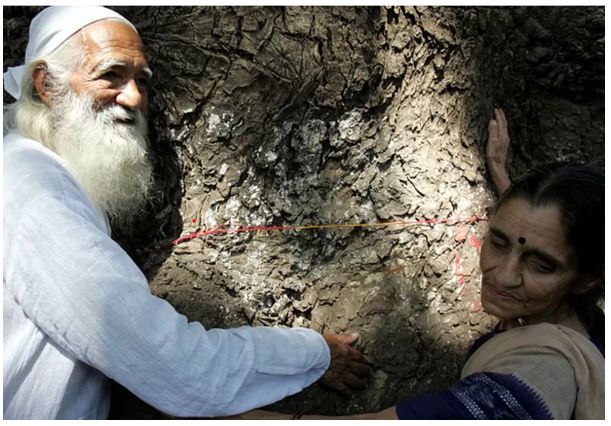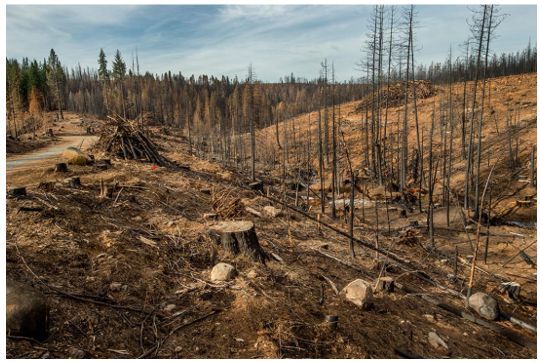1. Introduction
In a world grappling with the consequences of climate change and environmental degradation, the pivotal role of trees in sustaining life and preserving the delicate balance of our ecosystems cannot be overstated. Trees serve as the lungs of our planet, absorbing carbon dioxide, releasing oxygen, and mitigating the impacts of climate change. Yet, this vital resource is under threat from rampant deforestation, driven by factors such as industrialization, urbanization, and unsustainable agricultural practices. It is within this context that "The Chipko Movement" or "Chipko Andolan" was born out of the deep reverence for trees and the urgent need to protect them. It emerges as a remarkable example of grassroots activism and environmental conservation.
This Movement stands as an enduring testament to the power of grassroots mobilization and the profound ecological benefits of trees in sustaining our planet's delicate balance. Originating in the early 1970s in the Indian state of Uttarakhand, this remarkable environmental activism movement emerged as a response to rampant deforestation and the pressing need for sustainable development practices. Led by courageous women and visionary environmentalists like Sunderlal Bahuguna, the Chipko Movement not only succeeded in raising awareness but also sparked a global inspiration, leaving an indelible mark on the environmental movement.
The impact of the Chipko Movement extended well beyond the borders of Uttarakhand, resonating with environmentalists and activists worldwide. Its success in raising awareness about the destructive consequences of deforestation and advocating the rights of local communities to protect their natural resources served as an inspiration for similar movements across the globe. The principles and strategies employed by the Chipko Movement, such as nonviolent resistance, community participation, and a focus on sustainable development, continue to guide environmental activism today. This legacy states the power of collective action and the ability of individuals to create meaningful change, even in the face of formidable challenges.
Moreover, the Chipko Movement played a pivotal role in challenging prevailing notions of development that prioritized short-term economic gains over long-term environmental sustainability. By bringing attention to the intrinsic value of forests and the interconnectedness of ecosystems, the movement stimulated a broader dialogue on the need for holistic approaches to development. It emphasized the importance of incorporating ecological considerations and community perspectives into policy formulation, paving the way for more inclusive and environmentally conscious development models. The Chipko Movement's emphasis on the symbiotic relationship between humans and nature continues to shape contemporary discourses on sustainable development and serves as a reminder of the enduring wisdom held within Indigenous and local knowledge systems.
Understanding the historical significance of the Chipko Movement and the profound ecological benefits of trees is crucial in the context of the global environmental crisis we face today. With escalating concerns about climate change, deforestation, and loss of biodiversity, it is imperative to recognize the impact of trees in promoting sustainability and resilience.
This research delves into the historical context, objectives, and accomplishments of the Chipko Movement, while also exploring the multifaceted benefits of trees that make them vital to human survival and the preservation of the planet's delicate ecosystem. By examining the interplay between societal activism and the ecological value of trees, this study aims to shed light on the importance of environmental conservation movements in safeguarding our planet's future.
2. Evolution (History) - (why it became popular and evolution)
After the Sino-Indian border conflict concluded in 1963, Uttar Pradesh experienced a surge in development, particularly in the rural Himalayan region. The construction of internal roads for connectivity attracted foreign logging companies, eager to exploit the abundant forest resources in the area. However, the local villagers heavily relied on the forests for their livelihood, including food, fuel, water purification, and soil stability. Government policies restricted the villagers from managing the land and accessing timber, leading to mismanagement by commercial entities. The effects were severe, resulting in decreasing agricultural output, erosion, the depletion of water resources in previously forested areas, and an increase in flooding of the nearby communities1.
In 1964, Chandi Prasad Bhatt, an environmentalist and Gandhian social activist, established a cooperative society aimed at developing small-scale industries using local resources for the benefit of rural communities2. The turning point came in 1970 when heavy rains associated with industrial logging caused extensive damage, resulting in the death of over 200 people. This tragedy prompted a re-evaluation of practices by the Department of Geology and Mining (DGSM). The first Chipko protest occurred in April 1973 near Mandal village in the upper Alaknanda valley3. The name "Chipko", which means "to embrace", was given to the movement because the villagers, particularly the women, would encircle and hug the trees to keep them from being cut down. The villagers that were denied access to small-scale trees for their needs, protested against the government's approval of a larger project benefiting a sports product manufacturer. When their appeal was rejected, Chandi Prasad Bhatt led the villagers into the forest, embracing the trees to prevent their felling. After several days of protest, the government revoked the logging permits and granted the villagers the original allocation requested by the DGSM.
Following the success of this protest, Sundarlal Bahuguna, an activist and environmentalist led the movement and disseminated the strategies employed by the Chipko Movement to other villages in the region. Another significant protest took place in 1974 when the government intended to cut down over 2,000 trees near Raini village4. A large demonstration led by students and supported by neighbouring villagers resulted in the government offering compensation to the affected people. However, under the leadership of Gora Devi, the women of the village refused to leave the forest and compelled the loggers to retreat. This action prompted the state government to form a committee to investigate deforestation in the Alaknanda Valley and eventually impose a 10-year ban on commercial activities in the region. Since women exclusively formed the movement's core, it also indicates an eco-feminist movement.

Source: https://indianexpress.com/article/what-is/what-is-the-chipko-movement-google-doodle-5111644/
Although the protests were decentralized and autonomous, the Chipko movement gradually emerged as a movement advocating for the rights of peasants and women. In addition to the iconic act of tree-hugging, Chipko protesters utilized various techniques rooted in Mahatma Gandhi's concept of satyagraha (non-violent resistance). For instance, in 1974, Sunderlal Bahuguna embarked on a two-week fast to protest against forest policies5. In 1978, Dhoom Singh Negi, a Chipko activist, staged a protest against the auction of Advani Forest, during which local women tied sacred threads around the trees and recited the Bhagavad Gita6. In other instances, women wore resin-tapped chrysanthemums (Pinus Roxburgh) as headgear to protest against their exploitation. The movement spread to numerous villages, resulting in 12 major protests and several minor incidents in Uttarakhand between 1972 and 1979.

Source: https://www.bbc.com/news/world-asia-india-57171363
Initially, the government's response to the movement was not supportive. However, following the Reni incident, the Chief Minister of Uttar Pradesh, H.N. Bahuguna, acted by establishing a committee led by botanist Virendra Kumar to investigate the incident7. Another government committee, headed by K.M. Tewari, was also formed. Despite the preparation of detailed project reports by both committees, the government failed to implement their recommendations. However, when Sundarlal Bahuguna undertook an indefinite fast in April 1981, demanding a complete ban on tree felling in the Himalayas, the government, led by Mrs. Indira Gandhi, responded by recommending a 15-year ban on commercial tree felling in the Himalayan forests of Uttarakhand. This decision marked the movement's greatest victory8.
3. Paradigm shift in laws
The Chipko Movement had a significant impact on the development of environmental legislation in India through its widespread protests, activism, and public awareness campaigns. The movement's persistent efforts and sense of urgency resulted in several crucial legal changes that addressed various aspects of environmental protection and sustainable resource management.
One notable legislative change that followed the Chipko Movement was the implementation of the Forest Conservation Act in 19809. This law was a direct response to the movement's raised concerns and aimed to tackle deforestation by imposing stricter regulations on the diversion of forest land for non-forest purposes. The act emphasized the importance of obtaining permissions and conducting Environmental Impact Assessments before utilizing forest land for developmental projects. By promoting the preservation of forest ecosystems, this legislation played a significant role in curbing deforestation and promoting sustainable forest management practices.
In 1986, the introduction of the Environmental Protection Act reflected a comprehensive approach to addressing environmental issues. This legislation provided a legal framework for the protection and improvement of the environment. It included measures to prevent and control pollution, established guidelines for environmental impact assessments, and introduced mechanisms for pollution control. By emphasizing the consideration of environmental factors in decision-making processes, the act facilitated the integration of environmental considerations across various sectors.
Another significant legislative outcome influenced by the Chipko Movement was the National Forest Policy of 198810. This policy recognized the diverse roles that forests play in terms of ecology, economy, and society. It emphasized the sustainable use of forests and encouraged the participation of local communities in forest protection and management. By recognizing the rights and knowledge of forest-dwelling communities, the policy promoted their involvement in decision-making processes and the equitable sharing of benefits, fostering a more inclusive and fair approach to forest conservation.
The enactment of the Scheduled Tribes and Other Traditional Forest Dwellers (Recognition of Forest Rights) Act in 2006, commonly known as the Forest Rights Act11, aimed to rectify historical injustices faced by forest-dwelling communities, including tribal populations. This legislation granted legal recognition to the traditional rights and forest-dwelling practices of these communities, empowering them as stakeholders and enabling their participation in forest management and conservation. The Act sought to preserve their cultural heritage and promote a more inclusive approach to forest governance.
The Biodiversity Act of 2002 acknowledged the significance of conserving India's diverse biodiversity. This legislation established a legal framework for the protection and sustainable use of biological resources. It underscored the importance of conserving biodiversity and traditional knowledge, while ensuring the fair and equitable sharing of benefits derived from their utilization. The act contributed to the preservation of India's unique ecosystems and the sustainable management of its natural resources.
Additionally, amendments were made to the Indian Penal Code to address environmental offenses more effectively. These amendments included provisions to penalize activities such as illegal tree felling, wildlife trafficking, and water pollution. The intent was to strengthen enforcement mechanisms and serve as deterrents against environmental crimes.
The Chipko Movement's advocacy and impact played a pivotal role in shaping these legislative changes. By raising awareness about the significance of environmental conservation and the rights of local communities, the movement influenced policy and legal reforms. The resulting laws and regulations promote sustainable development, encourage community participation, and safeguard India's invaluable natural resources for present and future generations.
4. Relevance in contemporary world
The significance of the Chipko Movement in the modern world cannot be overstated. The movement's fundamental principles and strategies align with the pressing issues of our time and offer invaluable insights for addressing environmental challenges. Primarily, the Chipko Movement shed light on the vital interconnection between forests and communities. It highlighted how heavily local communities relied on the trees for their subsistence, providing them with resources like food, fuel, and more. In an era characterized by escalating urbanization and industrialization, the movement's emphasis on the rights and needs of forest-dependent communities serves as a potent reminder about the significance of sustainable development and equitable resource distribution.
Furthermore, the Chipko Movement showcased the power of grassroot level activism and community engagement in environmental decision-making processes. By mobilizing local villagers, particularly women, the movement demonstrated the strength and determination of ordinary individuals in safeguarding their natural environment. In today's world, where marginalized communities disproportionately withstand most of environmental degradation and climate change, the Chipko Movement's commitment to social justice and inclusivity remains profoundly relevant.
The movement also increased awareness regarding the preservation of ecosystems and biodiversity. Chipko activists recognized the crucial role of forests in maintaining ecological balance, climate regulation, and biodiversity conservation. Their endeavours to protect trees and prevent deforestation align with the growing global concern over habitat destruction, species extinction, and climate change. The legacy of the Chipko Movement serves as a poignant reminder of the urgent need to conserve and restore ecosystems for the well-being of both human communities and the planet as a whole.
Moreover, the Chipko Movement pioneered the use of nonviolent resistance as a potent tool for environmental advocacy. Drawing inspiration from Mahatma Gandhi's principles of satyagraha, or "truth force", the movement exemplified the effectiveness of peaceful protests, tree-hugging, and other nonviolent actions in drawing attention to environmental issues and challenging destructive practices. In an era marked by escalating environmental conflicts and the imperative implementation of sustainable solutions, the Chipko Movement's emphasised on nonviolent resistance, which provided a valuable model for bringing about change while fostering dialogue and understanding.
Lastly, the Chipko Movement precipitated legislative changes and policy reforms that continue to shape environmental governance not only in India but also on a global scale. The movement's successes in influencing forest conservation policies, recognizing the rights of local communities, and promoting sustainable resource management reflect the importance of 'bottom-up' approaches and 'grassroots' movements in shaping environmental laws and policies.
Global Effects
The movement also has influenced other environmental movements globally. A few instances include the Hambach Forest protests12 in Germany which is centred around the defence of an ancient forest threatened by lignite mining13. Similarly, the Great Barrier Reef campaign14 in Australia stresses on the importance of preserving fragile ecosystems, promoting sustainable practices, and engaging communities in conservative efforts.
The 'Protect the Arctic' campaign15 which aims to protect the Arctic region from oil drilling and other destructive activities emphasizes the need to preserve pristine environments, mitigate climate change, and uphold the rights of indigenous communities whose livelihoods are intimately connected to the Arctic's unique ecosystem.
The Ogoni Resistance Movement in Nigeria fought against the environmental degradation caused by oil extraction in the Niger Delta16. Led by Ken Saro-Wiwa, the movement advocated for the rights of local communities and raised awareness about the devastating impacts of oil pollution on ecosystems and livelihoods, mirroring the Chipko Movement's focus on community rights and the connection between environment and society.
5. Effects: Positive and Negative
The importance of afforestation in the modern world cannot be overstated. Afforestation, the process of establishing forests in areas where they did not previously exist, is a critical strategy to address environmental challenges, combat climate change, preserve biodiversity, and promote sustainable development. The various perspectives discussed above highlight the significance of afforestation initiatives in tackling pressing issues.

Source: https://greenstories.co.in/afforestation-saving-our-planet/
Here are key points regarding the relevance of afforestation in the contemporary world:
- Climate Change Mitigation17: Afforestation plays a vital role in mitigating climate change. By planting trees, we increase the carbon sequestration capacity of the planet. Trees absorb carbon dioxide from the atmosphere through photosynthesis and store carbon in their biomass and soils. Afforestation efforts on a large scale can contribute to reducing greenhouse gas emissions, stabilizing climate patterns, and mitigating the impacts of global warming.
- Ecosystem Restoration: Afforestation is instrumental in restoring degraded ecosystems. Many regions around the world have suffered from deforestation, habitat loss, and land degradation due to human activities. Afforestation projects can reclaim and rehabilitate these areas, restoring ecological balance, enhancing biodiversity, and creating habitats for diverse plant and animal species. Restoring ecosystems through afforestation is crucial for preserving natural heritage and ensuring the resilience of ecosystems in the face of environmental change.
- Soil Conservation and Watershed Protection18: Afforestation plays a crucial role in soil conservation and watershed protection. Trees help prevent soil erosion by reducing the force of wind and water on the land. Their root systems stabilize the soil, minimizing erosion and retaining water. By planting trees, we protect fertile soil, maintain water quality, and sustain the health of rivers, lakes, and watersheds. Afforestation initiatives contribute to maintaining the productivity of agricultural lands and ensuring the availability of clean water resources.
- Biodiversity Conservation19: Afforestation efforts contribute significantly to conserving biodiversity. Trees provide habitats for countless plant & animal species and fosters biodiversity hotspots. By creating new forests or expanding existing ones, we can provide shelter, food, and breeding grounds for a wide range of organisms. Afforestation initiatives help protect endangered species, preserve genetic diversity, and restore ecological corridors, enabling the movement of wildlife and facilitating ecosystem resilience.
- Sustainable Resource Management: Afforestation promotes sustainable resource management20. Forests provide valuable resources such as timber, non-timber forest products, and renewable energy. By establishing new forests or replenishing existing ones, we can ensure a sustainable supply of these resources for present and future generations. Afforestation initiatives also contribute to the development of sustainable livelihoods, supporting industries such as forestry, agroforestry, and eco-tourism.
- Community Engagement and Empowerment: Afforestation projects offer opportunities for community engagement and empowerment. Involving local communities in tree planting activities fosters a sense of ownership and stewardship over forests. It provides economic opportunities, empowers communities to participate in decision-making processes, and strengthens their resilience to environmental challenges. Afforestation initiatives can also contribute to cultural preservation and the revitalization of traditional knowledge related to forest ecosystems.
The relevance of afforestation in the modern world lies in its potential to address pressing environmental issues, promote sustainable development, and create a more resilient and equitable future. By supporting afforestation initiatives at local, national, and global levels, we can harness the power of forests to combat climate change, restore ecosystems, conserve biodiversity, protect watersheds, and promote sustainable resource management. Afforestation is a vital tool in building a sustainable and prosperous world for current and future generations.
- Deforestation
Deforestation has profound and wide-ranging effects on both local and global scales, with significant implications for ecosystems, biodiversity, climate change, and communities.

Source: https://daily.jstor.org/deforestation-lead-drought/
The relevance of the Chipko Movement and the global examples discussed above highlight the critical need to address the detrimental impacts of deforestation. Some of the effects are as follows:
- Loss of Biodiversity: Deforestation disrupts ecosystems and leads to the loss of biodiversity21. Forests are home to countless plant and animal species, many of which are endemic and endangered. The destruction of forest habitats through deforestation jeopardizes the survival of these species, resulting in a loss of biodiversity. This loss has ecological implications, as it disrupts intricate food webs, reduces ecosystem resilience, and diminishes the overall health and stability of ecosystems.
- Climate Change22: Forests play a vital role in mitigating climate change by acting as carbon sinks. Trees absorb carbon dioxide from the atmosphere during photosynthesis, reducing greenhouse gas levels and mitigating global warming. Deforestation releases large amounts of carbon dioxide into the atmosphere, contributing to the greenhouse effect and aggravate climate change23. The loss of forests also diminishes the Earth's capacity to regulate temperature, disrupts local and regional weather patterns, and impacts water cycles.
- Soil Erosion and Land Degradation24: Forests help prevent soil erosion and maintain soil fertility. The intricate root systems of trees bind the soil, preventing it from being washed away by rainfall or blown away by wind. When forests are cleared, the exposed soil is vulnerable to erosion, leading to land degradation. Soil erosion affects agricultural productivity, damages ecosystems, and contributes to sedimentation in rivers, lakes, and coastal areas, leading to further ecological and socioeconomic consequences.
- Disruption of Indigenous and Local Communities25: Deforestation often displaces indigenous and local communities who depend on forests for their livelihoods and cultural practices. These communities rely on forests for food, water, fuel, medicine, and other essential resources. When their access to forests is disrupted, it undermines their well-being, threatens their cultural heritage, and exacerbates social inequalities. The Chipko Movement's emphasis on community rights and sustainable development underscores the importance of safeguarding the rights and livelihoods of forest-dependent communities.
- Loss of Ecotourism and Economic Opportunities: Forests have significant economic value, particularly through ecotourism. Many forests attract visitors who appreciate their natural beauty, wildlife, and recreational opportunities. Deforestation diminishes these attractions, leading to a loss of tourism revenue and economic opportunities for local communities. Additionally, forests provide sustainable livelihood options such as sustainable timber harvesting, non-timber forest products, and eco-friendly industries. The destruction of forests deprives communities of these economic avenues.
The effects of deforestation are far-reaching, impacting ecosystems, biodiversity, climate, communities, and economies. Recognizing the relevance of the Chipko Movement and the lessons from global examples contribute significantly to combat deforestation, promote sustainable land management, and protect the rights of local communities. Implementing sustainable forestry practices, supporting reforestation initiatives, and fostering community-led conservation efforts are essential steps towards mitigating the detrimental effects of deforestation and ensuring a more sustainable and equitable future.
6. Conclusion
The Chipko Movement has been an outstanding example of activism and environmental conservation, which has significant impact in today's world. It was born out of the urgent need to protect trees and combat widespread deforestation. This movement has had far-reaching effects that continue to be relevant.
The success of the Chipko Movement in raising awareness about the destructive consequences of deforestation and advocating for the rights of local communities, has inspired similar movements throughout the country. Its principles of peaceful resistance, community involvement, and sustainable development, continue to shape environmental activism. This movement has challenged prevailing notions of development that prioritize short-term economic gains over long-term environmental sustainability, emphasizing the importance of incorporating ecological considerations and community perspectives in policymaking. The movement's advocacy and accomplishments has helped shape the legal framework for environmental protection, highlighting the significance of considering environmental factors in decision-making processes.
In the modern world, the principles and strategies of the Chipko Movement remain highly relevant. Its focus on the inter relation between forests and communities, the preservation of ecosystems and biodiversity, and nonviolent resistance align with the pressing environmental challenges we face today. It serves as a potent reminder of the need for sustainable development, social justice, and inclusive approaches to environmental conservation. Moreover, the movement has inspired environmental initiatives across the globe with its legacy being observed in campaigns aimed at protecting ancient forests, fragile ecosystems, and indigenous rights in various parts of the world. The movement has contributed to a global awareness of the necessity to preserve pristine environments, address climate change, and uphold the rights of marginalized communities.
While the Chipko Movement has brought about positive changes, it is important to acknowledge the challenges and complexities that arise in environmental activism. The movement initially lacked support from the government and encountered obstacles in implementing its recommendations fully. However, the persistence and determination of its activists resulted in significant victories throughout its journey.
In conclusion, the Chipko Movement stands as a powerful testament to the potential of collective action and the profound ecological benefits of trees. It continues to inspire and guide environmental activism, shaping laws and policies, and emphasizing the importance of sustainable development, community participation, and the preservation of ecosystems. The movement's relevance today emphasizes the urgency of addressing environmental challenges and the potential of individuals and communities to bring about meaningful change. Understanding the historical significance of the Chipko Movement is crucial for safeguarding the future of our planet and promoting a more sustainable & equitable world.
Footnotes
*Slogan for Chipko Movement by Sunderlal Bahuguna
1 Melissa Petruzzello (2015). Chipko movement | History, Causes, Leaders, Outcomes, & Facts, Britannica. Available at: https://www.britannica.com/topic/Chipko-movement.
2 Melissa Petruzzello (2015). Chipko movement | History, Causes, Leaders, Outcomes, & Facts, Britannica. Available at: https://www.britannica.com/topic/Chipko-movement.
3 Simran Bedi (2022). The Chipko Movement: Treehuggers of India. The Nonviolence Project. Available at: https://thenonviolenceproject.wisc.edu/2022/04/18/the-chipko-movement-treehuggers-of-india/
4 Barnali Kalita (2015). Chipko Movement: A Landmark Effort In Addressing Environmental Crisis In India, International Journal of Interdisciplinary Research and Innovations, ISSN 2348-1218 (print), ISSN 2348-1226 (online), Research Publish Journals. Available at: https://www.researchpublish.com/papers/chipko-movement-a-landmark-effort-in-addressing-environmental-crisis-in-india.
5 The Hindu (2021). Chipko: A movement that gave forest conservation a new life. Available at: https://frontline.thehindu.com/environment/photo-essay-chipko-a-movement-that-gave-forest-conservation-a-new-life/article35831455.ece.
6 Id at note 5
7 Barnali Kalita (2015). Chipko Movement: A Landmark Effort In Addressing Environmental Crisis In India, International Journal of Interdisciplinary Research and Innovations, ISSN 2348-1218 (print), ISSN 2348-1226 (online), Research Publish Journals. Available at: https://www.researchpublish.com/papers/chipko-movement-a-landmark-effort-in-addressing-environmental-crisis-in-india.
8 Ministry of Women and Child Development (2015). Report of the High-Level Committee on the Status of Women in India. Available at: https://wcd.nic.in/sites/default/files/Vol%204.pdf.
9 Amit Mitra (1993). Chipko: an unfinished mission. Available at: https://www.downtoearth.org.in/coverage/chipko-an-unfinished-mission-30883
10 https://mpforest.gov.in/img/files/Policy_NFP.pdf
12 The Guardian (2018). Thousands of anti-coal protesters celebrate German forest's reprieve. Available at: https://www.theguardian.com/environment/2018/oct/06/thousands-of-anti-coal-protesters-celebrate-german-forests-reprieve
13 NDTV (2017). A 'Chipko Movement' In Germany Is Trying To Save Europe's Oldest Forest. Available at: https://www.ndtv.com/world-news/a-chipko-movement-in-germany-is-trying-to-save-europes-oldest-forest-1778401.
14 WWF Australia (2013). Fight for the Reef. Available at: https://wwf.org.au/what-we-do/oceans/great-barrier-reef/fight-for-the-reef/.
15 Greenpeace (2019). Protect the Arctic. Available at: https://www.greenpeace.org/usa/issues/protect-the-arctic/
16 Global Nonviolent Action Database (2011). Ogoni people struggle with Shell Oil, Nigeria, 1990-1995, Available at: https://nvdatabase.swarthmore.edu/content/ogoni-people-struggle-shell-oil-nigeria-1990-1995.
17 https://www.earthreminder.com/afforestation-advantages-disadvantages/
18 Vildan Sahin, and Michael J. Hall (1996). The effects of afforestation and deforestation on water yields. online 178(1-4), pp.293-309. doi: https://doi.org/10.1016/0022-1694(95)02825-0.
19 Ásrún Elmarsdóttir et al (2008). Effects of afforestation on biodiversity. https://www.researchgate.net/publication/242146361_Effects_of_afforestation_on_biodiversity
20 https://www.conserve-energy-future.com/importance-advantages-afforestation.php
21 https://thehumaneleague.org/article/effects-of-deforestation
22 https://www.lse.ac.uk/granthaminstitute/explainers/whats-redd-and-will-it-help-tackle-climate-change/#:~:text=Deforestation%20refers%20to%20the%20purposeful,contributes%20to%20climate%20change%EF%BB%BF.
23 https://eos.com/blog/deforestation-and-greenhouse-gases/
24 https://pachamama.org/effects-of-deforestation
25 Supra at note 22
This article is for information purpose only. It is not intended to constitute, and should not be taken as legal advice, or a communication intended to solicit or establish commercial motives with any. The firm shall not have any obligations or liabilities towards any acts or omission of any reader(s) consequent to any information contained herein. The readers are advised to consult competent professionals in their own judgment before acting on the basis of any information provided hereby.


